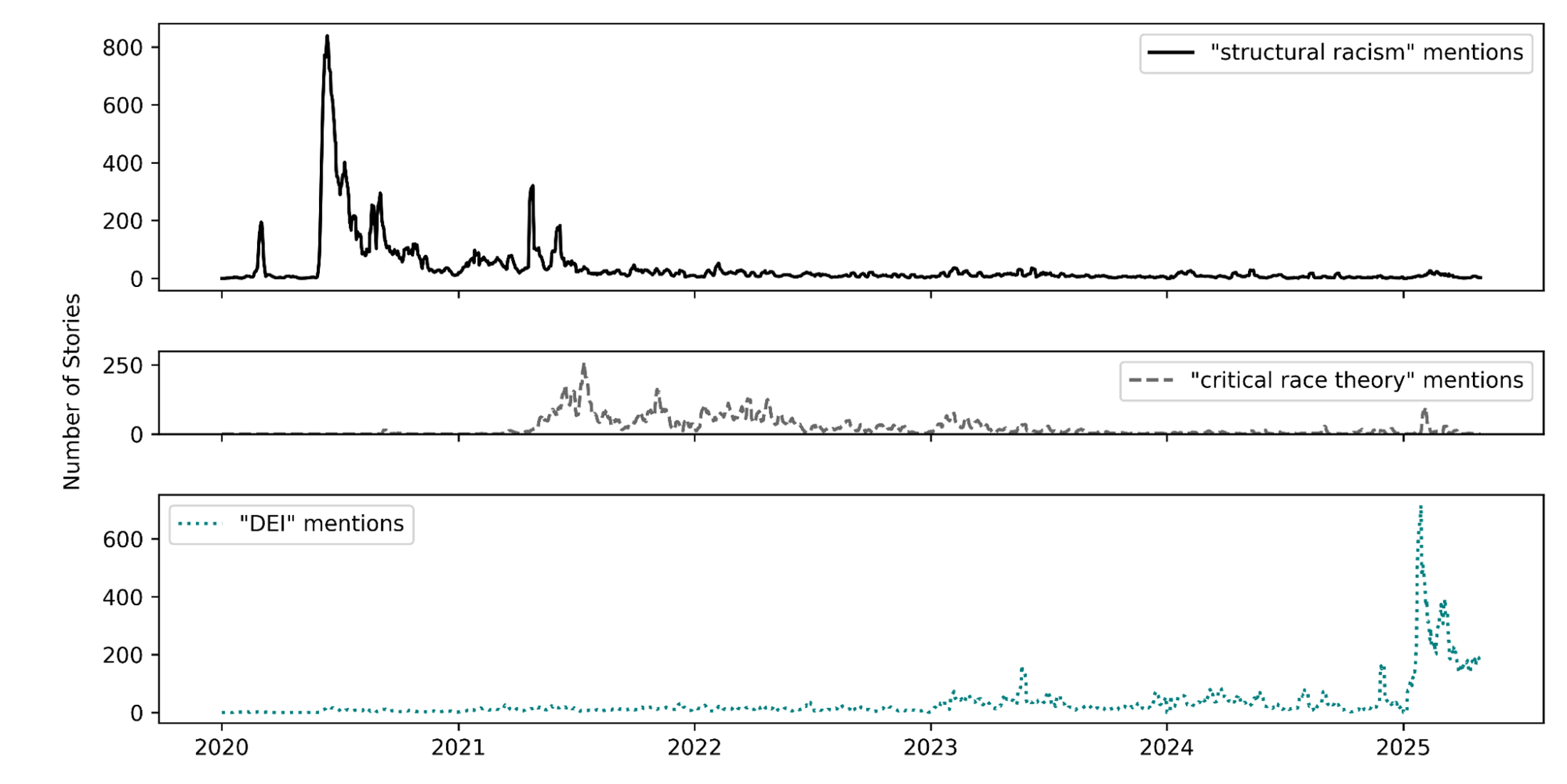An Update on Attention to Racism and Counter-Messaging in 2025
The Collaborative on Media and Messaging (COMM) for Health and Social Policy has previously identified evidence for robust and growing counter-messaging and news attention to policies and initiatives designed to combat structural racism and health equity.
Given the second Trump Administration’s focus on dismantling diversity, equity, and inclusion (DEI) programs, it seemed likely that local TV news attention to these concepts would have grown since Trump took office. In an updated analysis of trends in local TV news coverage that extends through April 2025, and in light of the 5-year anniversary of George Floyd’s murder, we confirm not only that news attention to counter-messaging has grown but also that the news attention it has received in early 2025 is of a magnitude similar to the level of attention to structural racism in the wake of George Floyd’s murder and disparities revealed by the COVID-19 pandemic in the summer of 2020.
As shown in Figure 1 below, attention to DEI in local TV news in particular spiked following Inauguration Day as Trump signed the first of a series of executive orders targeting diversity policies and programs in the public and private sectors alike. Moreover, attention to DEI has remained high (with seven-day averages hovering around 200 stories) since February. These data come from keyword and pattern searches of the closed captioning on local TV news programs (790 stations affiliated with ABC, CBS, NBC, Fox, and PBS across 212 U.S. local media markets) from January 1, 2020 through April 30, 2025.
Figure 1. Local media attention to structural racism, critical race theory and DEI initiatives. Trendlines are seven-day rolling averages.

This sustained attention – which likely can be attributed not only to Trump executive orders and discourse as well as responses from the corporate, education, and non-profit sectors – is not only large, but as demonstrated by the top trendline, it lacks inclusive discussion of structural racism concerns that led to the adoption of many of these programs and initiatives in the first place. As we identified in January, these trends fit the pattern of progress on social justice being followed by the politics of backlash.
Our ongoing work-in-progress suggests that growing backlash against DEI initiatives is accompanied by heightened contention between different perspectives and discussion of controversy. This assessment might explain why opinion about DEI has polarized but not cratered, with political Independents along with Democrats being much more supportive of DEI programs than Republicans. Importantly, survey work has shown that support for the underlying ideas surrounding diversity, equity, and inclusion are still widely supported when the term DEI itself is excluded, and some corporations are reporting consequences of their decisions to roll back DEI. That said, advocates for racial and health equity continue to face strong anti-messaging headwinds that have only increased in the media attention cycle in 2025.
Read more relevant work from the COMM team:
- Our earlier report on attention to, predictors of, and potential consequences of racism and counter-messaging in mainstream media
- What was and wasn’t featured in 2024 campaign advertising
- How political candidates discussed racial and gender identity in 2022 – and what it means for 2024
- What role did local news play in the controversy about masks?
The ongoing work-in-progress described here includes contributions from Meiqing Zhang, Natália de Paula Moreira, Breeze Floyd, Steven Moore, Erika Franklin Fowler, Yujin Kim, Furkan Cakmak, Neil Lewis, Jr., Jeff Niederdeppe, and Sarah Gollust. Support for this research was provided by the Robert Wood Johnson Foundation (grant #79754). The views expressed here do not necessarily reflect the views of the Foundation.